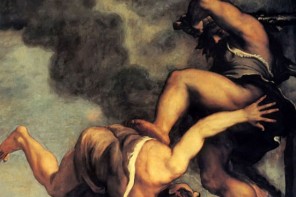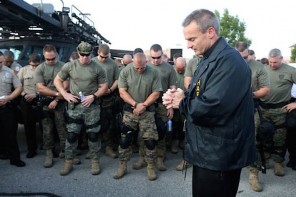On Tuesday December 8, a proposed settlement was announced in Cobell v. Salazar—frequently referred to as the Cobell Lawsuit. Named for lead plaintiff Eloise Cobell, a Blackfoot Indian and banker, it may be the largest class-action lawsuit against the US government in history.
Out of notice of most Americans and understood by few, Eloise Cobell and a group of Indians filed suit in 1996 against the Department of the Interior and included as plaintiffs every Indian who had ever had their own money handled by the Bureau of Indian Affairs Indian trust management officials over the previous hundred years.
Indians and Competency
Moses Bruno, my great-grandfather, was “given” eighty acres of land by the US government in 1887 when he was fourteen years old. The land was his anyway since it belonged to the Citizen Potawatomi tribe and Moses was a tribal member as were his parents, grandparents, children, grandchildren, and great-grandchildren, including me.
When I was a kid I my grandpa used to tell stories about a horse named Champ. Champ was one of a matched set of plow horses my grandpa’s daddy bought when the family came into some oil money during the Great Depression, and therein is a tale of how to cheat Indians.
What pulls together the Cobell lawsuit, my great-grandfather Moses Bruno, and a horse named Champ is the fact they were all considered incompetent in the eyes of the US government. That’s right, a Blackfoot Indian banker with a college degree, a Potawatomi who was given his own land to become a farmer, and a plow horse named Champ are all incompetent to handle their own affairs according to the Bureau of Indian Affairs.
Eloise Cobell went off to college, came home to Montana, and eventually ended up as a banker. One day she went to the Bureau of Indian Affairs and tried to find out how much “Indian Money” she had in her individual trust fund account and was told that no one knew the amount, but to “trust” them, since they knew.
That was a lie.
Remember, when Indians were given land by the Dawes Allotment Act in 1887, we already owned the land but it was owned in common by all in the tribe. In the debate over the passage of the Dawes Act, the legislation was sold to the ignorant and Indians as a way to make Indians into farmers by giving them manageable tracts of land and holding it in trust for them since they were incompetent to handle the land or the money generated on the land.
Heads of household received tracts of 160 acres, the same amount “given” to immigrants under the Homestead Act, minors like Moses Bruno was given 80 acres, and chiefs (not women) and headmen (sometimes women) were given 320 acres.
Somehow the history of how Indians taught the Pilgrims to farm, how they had been farming in America for thousands of years, was lost on the American public. By this time America was saturated with images of Indians riding horseback after buffalo; kind of like a Sunday football game between the teams from Washington DC and upstate New York.
Because Indians did not know how to farm, could not handle money, and were measured for their degree of civilization by the amount of white blood they carried, a whole system of trust fund management was set up to handle the land and the money for them. The trust fund accounts were called IIM (Individual Indian Money) accounts and were managed by the BIA because Indians were, and still are, considered incompetent to handle our own money.
At first, the money generated by the lands were piddling, but after the turn of the century oil was discovered on the lands of Indians in Oklahoma, including Moses Bruno’s eighty acres south of Shawnee Oklahoma. By a horrible trick of fate, the worst of our own lands given to us tragically contain vast amount of timber, coal, uranium, oil, and natural gas.
From 1923 when the first oil lease was granted on my great-grandfather’s land, until 2000, the last year records were made available, that eighty acres generated more than four million barrels of oil. According to the BIA rules and regulations, Bruno’s IIM account was supposed to receive 12 ½ percent of the royalties from that oil.
In truth, he only received 23 thousand dollars and change over thirty years before the land was sold to satisfy a grocery bill and the cost of burying him and his wife Frances, my great-grandmother, also an allotee. The last years of his life Moses and Frances were on public relief because the four wells pumping on his land at the time of his death were generating income for someone else, not him.
As for Champ the plow horse?
By the time my great grandfather received his first royalty checks during the Depression, the oil companies had pumped millions of gallons of salt water and oil production waste over his lands and down the creek. It would have been pointless to buy a tractor to work lands that to this day grow nothing but saltbush and weeds. So he bought a matched set of plow horses.
Oil and trust accounts and a government that gives 80 acres for every thousand it takes he could not understand. Horses made sense.
Besides handling the money they did not give to Moses Bruno and Eloise Cobell, the BIA is also supposed to enforce the rules about how energy companies operate on Indian land. The BIA was supposed to make sure that mud and water pits for oil drilling were fenced off for safety of people and animals.
But they never did.
One day Champ got off in the mud pit and no matter how hard they tried, they could not pull that horse out of the pit. So they had to shoot him in order to drag his carcass out of the mud so the oil company would not suck up a live plow horse instead of drilling mud.
Whenever my grandpa used to tell the story about Champ and his untimely death in a mud pit, the end of the story was that he applied to the BIA for 75 dollars compensation for the horse. He also tried to find out how the oil companies could pump millions of barrels of oil from his father’s land and he had to live on welfare. The BIA said the records burned in a fire, could not be located, did not exist, and as an incompetent Indian he did not have the right to records of his own land.
They lied.
In 1998 our family found the records of the history of oil production and the role of the BIA and oil companies on Moses Bruno’s land. We found the records in the National Archives in Fort Worth, Texas and when the librarians brought the boxes and boxes of letters and documents out for us to read, my mother and aunt and cousins, well, we cried.
In a two year exchange of letters between the BIA and the oil companies it was decided that even though the fencing for the mud pits was not in place, it was posted with signs.
Trouble was, the horse could not read. And neither could Moses Bruno. See, both he and the horse Champ did know Potawatomi but the signs were in English.




